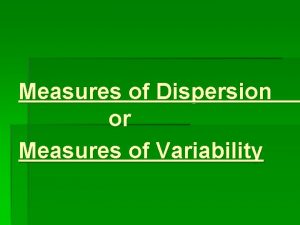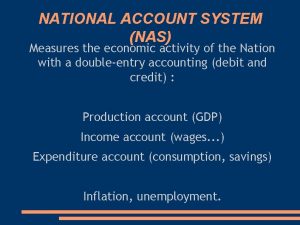Measures of Economic Activity Measures of Economic Activity















- Slides: 15

Measures of Economic Activity

Measures of Economic Activity � Recall, there are three ways to measure the value of aggregate output, suggested by the circular flow income model, all giving rise to the same results � 1) Expenditure Approach: adds up all spending to buy final goods and services produced within a country over a period. o GDP = C + I + G + (X − M) � 2) Income Approach: adds up all income earned by the factors of production that produce all goods and services within a country over a time period. o GDP = W + I + R + P � 3) Output Approach: calculates the value of all final goods and services produced in a country over a time period.

Distinction between GDP & GNP � Gross domestic product (GDP): is the market value of all final goods and services produced in a country over a time period, usually a year. o GDP = C + I + G + (X − M) � Gross national product (GNP/GNI): is the value of all final goods and services produced by the factors of production supplied by a country’s residents regardless of where the factors are located. o GNP = GDP + Income from abroad − Income sent abroad = GDP + Net income from abroad � Green GDP: is an adjustment of traditional GDP, deducting resource and environmental costs in economic activities. o Green GDP = GDP − Value of environmental

Calculating GDP �Example; The table below shows the spending components for the United States national income in 2013. Component Value (in trillions) Consumption (C) $11. 5 Investment (I) $2. 67 Government Spending (G) $3. 13 Exports (X) $2. 10 Imports (M) $2. 67 o GDP = C + I + G + (X − M) = $11. 5 + $2. 67 + $3. 13 + ($2. 10 − $2. 67) = $16. 73 trillion

Calculating GNP �Example; Suppose in 2013, Canada’s GDP was $1, 821 billion; Income earned abroad and sent home to Canada was $110 billion; Income earned in Canada and sent abroad was $29 billion. What was Canada’s 2013 GNP? o GNP = GDP + Net income from abroad = $1, 821 + ($110 − $29) = $1, 902 billion �Since GNP > GDP it indicates that Canada has significant foreign presence, in either workers or companies.

Real GDP & Nominal GDP �Nominal GDP: is measured in terms of current output valued at current prices, which does not account for changes in prices. �Real GDP: is a measure of economic activity that has eliminated the influence of changes in prices. o It measures the value of current output valued at constant prices so a relative comparison can be made to the base year o It is important to use real values when GDP is being compared over time

Example; Real GDP & Nominal GDP Calculating Nominal GDP 2001 Item Quantity Pric e 2002 2003 Valu e Quantit y Pric e Valu e Quantit Price Value y Burgers 37 $3 $111 40 $4 $160 39 $5 $195 Haircuts 15 $18 $270 17 $20 $340 18 $21 $378 Tractors 10 $500 11 $60 $660 10 $650 Nominal GDP $881 $116 0 Calculating Real GDP (Base year 2001) 2001 Item Quantity Pric e 2002 Valu e Quantit y Pric e Valu e $122 3 2003 Quantit Price Value y Burgers 37 $3 $111 40 $3 $120 39 $3 $117 Haircuts 15 $18 $270 17 $18 $306 18 $324 Tractors 10 $500 11 $50 $550 10 $500 Real GDP $881 $976 $941

GDP Deflator �The GDP deflator is a price index that is an indicator of price changes for all good and services produced in the economy o GDP Deflator = (Nominal GDP ÷ Real GDP) × 100 o The index number for the base year is always 100, for all indices o An increasing GDP deflator indicates rising prices on average, while a decreasing GDP deflator indicates falling Yearprices. Nominal Real GDP GDP Deflator 2001 $881 100 2002 $1160 $976 118. 8 2003 $1223 $941 130

GDP Deflator & Real GDP � The GDP deflator is a price index that is commonly used to covert nominal GDP to real GDP. o Real GDP = (Nominal GDP ÷ GDP Deflator) × 100 = (Nominal GDP ÷ CPI) × 100 � Example; Suppose the nominal GDP was $7, 850 billion in 2001; $9, 237 billion in 2002; and $10, 732 billion in 2003. The GDP deflator was 100 in 2001; 118. 8 in 2002; and 130 in 2003. o Real GDP 2001 = ($7, 850 ÷ 100) × 100 = $7, 850 billion o Real GDP 2002 = ($9, 237÷ 118. 8) × 100 = $7, 775 billion o Real GDP 2003 = ($10, 732 ÷ 130) × 100 = $8, 255 billion

Calculating Economic Growth �Recall, economic growth refers to an increase in real GDP over time. o It is usually expressed as a percentage change in real GDP over a specified period of time. o %∆GDP= (GDPNEW − GDPOLD) ÷ GDPOLD �It is important to distinguish between a decrease in GDP and a decrease in GDP growth o A decrease in GDP involves a fall in the value of output produced, which gives rise to a negative growth rate o A decrease in GDP growth, involves falling rates of growth, but the rates may be positive

Example; Economic Growth �Example; Given the values for real GDP we can calculate the growth rates between successive years. Year Real GDP ($ Billion) Growth Rate Description 2010 210 − − 2011 215. 5 2. 6% Increasing GDP 2012 219. 5 1. 9% Falling GDP growth 2013 223. 1 1. 6% Falling GDP growth 2014 217. 0 − 2. 7% Negative GDP growth

Keynesian Multiplier �Keynesian Multiplier (k): tells us the amount by which a particular injection of government spending, investment, or export spending will increase the nation’s total GDP �The spending multiplier is a function of the marginal propensity to consume and is determined from the formula, o k = Change in Real GDP ÷ Initial Change in Expenditure = 1 ÷ (1 − MPC) = 1 ÷ (MPS + MPT + MPM) �Recall, that MPC + MPS + MPT + MPM = 1 since if national income increases fractions of the funds will be consumed, saved, taxed and spent on imports

�The larger the MPC and the smaller the leakages from the spending stream, the greater the value of the multiplier �The change in GDP (∆GDP) resulting from an initial change in expenditures (∆E) is, o ∆GDP = k × ∆E �Example; Suppose the economy is in a recession and the government increases expenditures by $8 million. Assuming the MPC = 0. 75 we can determine the value of the multiplier and change in real GDP. Round ∆GDP ($ million) ∆Consumption ($ million) 1 8 0. 75 × 8 = 6 2 6 0. 75 × 6 = 4. 5 3 4. 5 0. 75 × 4. 5 = 3. 38 4 3. 38 0. 75 × 3. 38 = 2. 5 Total 32 0. 75 × 32 = 24

�The Keynesian multiplier, k = 1 ÷ (1 − MPC) = 1 ÷ (1 − 0. 75) =4 �Real GDP increases more than proportionally and the government expenditure of $8 million increases real GDP by $32 million. ∆GDP = k × ∆E = 4 × $8 = $32 million

Study Questions o 1. You are given the following information on an imaginary country called Lakeland. Year Nominal GDP 2007 2008 6 2009 2010 19. 9 20. 7 22. 6 22. 3 21. 9 o A. Which year is the GDP 98. 5 base 100 year 102. 3 107. 6 103. 7 Deflatorreal GDP for each of the five years in the o B. Calculate table o 2. Calculate nominal GDP, given the following information from the national accounts of Flatland (all figures are in billions). Consumer spending $125; Government spending $46; Exports of $12 and imports of $17.
 Repeated measures design vs independent measures design
Repeated measures design vs independent measures design Economic growth vs economic development
Economic growth vs economic development Conclusion of growth and development
Conclusion of growth and development Economic systems lesson 2 our economic choices
Economic systems lesson 2 our economic choices Economic activity
Economic activity Quaternary economic activity
Quaternary economic activity Define circular flow of economic activity
Define circular flow of economic activity Welcome to service
Welcome to service Chapter 3 economic activity in a changing world
Chapter 3 economic activity in a changing world What are the levels of economic activity?
What are the levels of economic activity? Chapter 3 economic activity in a changing world
Chapter 3 economic activity in a changing world Quinary sector
Quinary sector Principles of a market economy
Principles of a market economy What are quaternary economic activities
What are quaternary economic activities Chapter 3 economic activity in a changing world
Chapter 3 economic activity in a changing world Fishing is a primary activity
Fishing is a primary activity



























